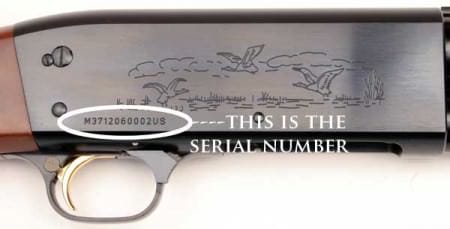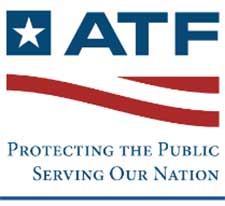
Washington, DC –-(Ammoland.com)- ATF Rul. 2012-1 : The Bureau of Alcohol, Tobacco, Firearms and Explosives (ATF) has received inquiries from manufacturers asking when they must mark the firearms they manufacture.
They ask specifically whether the requirement to record firearms in their records of manufacture within seven days also requires marking within that time period.
Some licensed firearms manufacturers produce and assemble complete firearms within their licensed business premises. Others manufacture only frames or receivers that are not parts of complete weapons when transferred to other licensees for further manufacturing. In some instances, a manufacturer may possess firearm frames or receivers for an extended period of time without selling, shipping, or otherwise disposing of them. Such manufacturers may intend to sell these components as frames or receivers without further manufacturing, or intend to manufacture complete weapons from them in the future.
The Gun Control Act (GCA) at 18 U.S.C. 921(a)(3) and its implementing regulation, 27 CFR 478.11, define the term “firearm,” in part, to mean: “any weapon (including a starter gun) which will or is designed to or may readily be converted to expel a projectile by the action of an explosive,” and includes “the frame or receiver of any such weapon.” The term “firearm frame or receiver” is defined by section 478.11 as “[t]hat part of a firearm which provides housing for the hammer, bolt or breechblock, and firing mechanism, and which is usually threaded at its forward position to receive the barrel.” Under 18 U.S.C.
923(i) and 27 CFR 478.92, licensed manufacturers and licensed importers must “identify, by means of a serial number engraved or cast on the receiver or frame of the weapon, in such manner as the Attorney General shall by regulations prescribe, each firearm imported or manufactured . . . .” Federal regulations at 478.92(a)(1) require manufacturers to identify each firearm by engraving, casting, stamping (impressing), or otherwise placing certain additional information (the model, caliber/gauge, manufacturer’s name, and place of origin) on the frame, receiver, or barrel, at a minimum depth. Paragraph 478.92(a)(2) specifies that a “firearm frame or receiver that is not a component part of a complete weapon at the time it is sold, shipped, or otherwise disposed of . . . must be identified as required by this section.” As to recordkeeping, section 478.123(a) provides that “[e]ach licensed manufacturer shall record the type, model, caliber or gauge, and serial number of each complete firearm manufactured or otherwise acquired . . . not later than the seventh day following the date such manufacture or acquisition was made.” (emphasis added)
Congress did not specify in section 923(i) a time period for a manufacturer to mark firearms manufactured. However, it is unlikely Congress intended to allow manufacturers to stockpile completed firearms (including finished frames or receivers of such firearms to be sold or shipped separately) without markings for an indefinite period of time. The plain language in section 923(i) requiring that the serial number be “engraved or cast on” the receiver or frame of the firearm demonstrates Congressional intent to require marking as an integral part of the manufacturing process. Otherwise, fully assembled firearms, or finished frames and receivers to be sold, shipped, or disposed of separately – stockpiled indefinitely without required markings – would be susceptible to theft or loss without any means to trace them.
Under the regulations, section 478.92, firearms required to be marked at the time of manufacture include both “complete weapons,” and complete frames or receivers of such weapons that are to be sold, shipped, or otherwise disposed of separately. Because identifying firearms is an integral part of the manufacturing process, and sections 923(i) and 478.92 do not specify a time period in which to identify firearms, licensed manufacturers are required to mark them during the manufacturing process. Reading the marking requirement for complete weapons in section 478.92(a) together with the seven day recordkeeping requirement for complete firearms in section 478.123(a), ATF concludes that it is reasonable for a manufacturer to have seven (7) days following the date of completion (to include a firearm in knockdown condition, i.e., complete as to all component parts, or a frame or receiver to be sold, shipped, or disposed of separately) in which to mark the firearm and record its identifying information in the manufacturer’s permanent records. Further, because firearm frames and receivers to be sold, shipped, or disposed of separately do not have a barrel at the time they are marked, pursuant to 478.92(a)(2), all of the information required by 478.92(a)(1) must be placed on the frame or receiver, unless an alternate means of identification is approved (i.e., a “non-marking variance”) under section 478.92(a)(4). The model designation and the caliber or gauge may be omitted without a variance if that information is unknown at the time the firearm frames or receivers are marked.
Nonetheless, ATF recognizes that a manufacturer may require more than seven days to finish the manufacturing process from beginning to end with the required markings, depending on the nature of the process involved. Some firearms may take more time due to differences in the type and capability of the firearm, availability of materials and components, and complexity of the assembly and finishing processes. ATF also recognizes that the equipment necessary to identify the firearms must be available and in working order. However, once the entire manufacturing process has ended, manufacturers must ensure that the firearms have been marked in the manner required by section 478.92.
To facilitate inspection and ensure that ATF can determine that a licensed manufacturer has not unreasonably held completed firearms (to include finished frames and receivers to be sold, shipped, or disposed of separately) after seven (7) days from the date of completion without their required markings, licensees may take the following steps:
- (1) maintain a copy of the current, active license of all contracted licensees;
- (2) maintain records of firearms production;
- (3) maintain work orders, contracts, and related instructions for services rendered that describe the various firearm manufacturing processes;
- (4) maintain orders for firearm parts that have yet to be received; and (5) maintain invoices to repair non-functioning machines.
Held, all firearms manufactured, to include firearm frames and receivers that are to be sold, shipped, or otherwise disposed of separately, must be identified by a licensed manufacturer in the manner and with the markings required by 18 U.S.C. 923(i) and 27 CFR 478.92 during the manufacturing process.
Held further, it is reasonable for a licensed manufacturer to have seven (7) days following the date of completion (to include a firearm in knockdown condition, i.e., complete as to all component parts, or a frame or receiver to be sold, shipped, or disposed of separately) in which to mark a firearm manufactured, and record its identifying information in the manufacturer’s permanent records.
Held further, a firearm frame or receiver that is not a component part of a complete weapon at the time it is sold, shipped, or otherwise disposed of must be marked with all of the required markings; provided, that an alternate means of identification may be approved (i.e., a “non-marking variance”) under section 478.92(a)(4); provided further, that the model designation and caliber or gauge may be omitted without a variance if that information is unknown at the time the frames or receivers are marked.
This ruling is limited to an interpretation of the requirements imposed upon licensed manufacturers under the Gun Control Act of 1968, 18 U.S.C. 921 et. seq., and does not apply to persons making or manufacturing firearms subject to the National Firearms Act, 26 U.S.C. 5801 et. seq. To the extent this ruling may be inconsistent with any prior letter rulings, they are hereby superseded. Date approved: January 12, 2012
B. Todd Jones, Acting Director, ATFAbout ATF:
ATF is a law enforcement agency in the United States’ Department of Justice that protects our communities from violent criminals, criminal organizations, the illegal use and trafficking of firearms, the illegal use and storage of explosives, acts of arson and bombings, acts of terrorism, and the illegal diversion of alcohol and tobacco products. We partner with communities, industries, law enforcement, and public safety agencies to safeguard the public we serve through information sharing, training, research, and use of technology.

